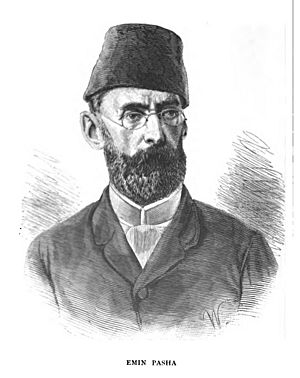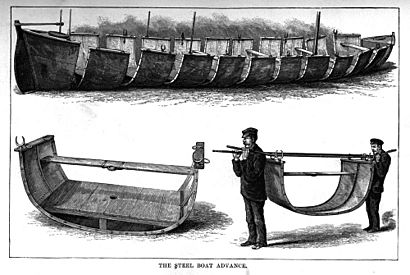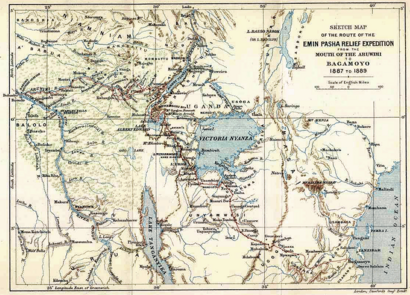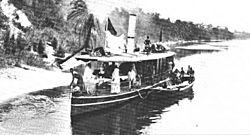Emin Pasha Relief Expedition facts for kids
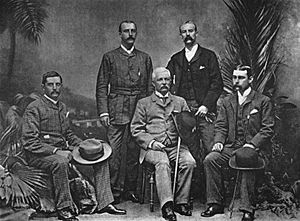
The Emin Pasha Relief Expedition was a big journey into Africa between 1887 and 1889. It was one of the last major European trips into the continent during the 1800s. The expedition was led by Henry Morton Stanley, a famous explorer. Its main goal was to help Emin Pasha, who was the Egyptian governor of a region called Equatoria. This area is now part of South Sudan. Emin Pasha and his people were surrounded by a group called the Mahdists.
Stanley and nearly 700 men set out to cross Africa. They traveled up the Congo River and then through the thick Ituri Rainforest. Their aim was to reach East Africa. The journey was extremely hard, so Stanley had to split his group into two parts. The first group, called the "advance column," finally reached Emin Pasha in July 1888. However, problems like disagreements and poor communication meant Stanley and Emin had to leave Equatoria in early 1889.
At first, people celebrated the expedition for its brave journey across "Darkest Africa." But soon after Stanley returned to Europe, the trip became famous for sad reasons. Many members died, and there were many stories of harsh treatment. The expedition also accidentally spread diseases. This was the last big private expedition during the time known as the Scramble for Africa.
Contents
Why the Expedition Happened
In 1885, a group called the Mahdists took control of Khartoum. This caused the Egyptian government in Sudan to fall apart. Equatoria, a southern part of Sudan, became almost completely cut off from the outside world. It was located near Lake Albert on the upper Nile river.
Emin Pasha was a doctor and a scientist from Germany. He had been made Governor of Equatoria by Charles George Gordon. Gordon was a British general who had tried to help Khartoum. Emin could send and receive letters through Buganda and Zanzibar. In 1886, he learned that the Egyptian government would leave Equatoria. A missionary named Alexander Murdoch Mackay encouraged him to ask the British government to take over Equatoria. The British government was not interested. However, the British public began to see Emin as another General Gordon, in great danger from the Mahdists.
A Scottish businessman named William Mackinnon was involved in many colonial projects. By November 1886, he asked Stanley to lead a rescue mission. Stanley quickly agreed to go. Mackinnon then teamed up with James Frederick Hutton to create the "Emin Pasha Relief Committee." This group, mostly Mackinnon's friends, raised about £32,000.
Stanley was still working for Leopold II of Belgium, who ruled the Congo Free State. To let Stanley go, King Leopold agreed that the expedition would take a longer route up the Congo River. In return, Leopold would provide his ships to transport the expedition up the river.
By January 1887, Stanley was back in London. He was preparing the expedition, and everyone was excited. Stanley himself said the expedition was meant to help people, not to conquer land.
What Was the Expedition's Real Goal?
After the expedition, Stanley often said that its only goal was to help Emin Pasha.
However, Stanley's other writings suggest a second goal: taking over land. He hinted that his meeting with the Sultan of Zanzibar was about British interests in East Africa. These interests were threatened by the Mahdists and by Germany's own plans in the area. Germany did not fully recognize Britain's control over Zanzibar until 1890.
Records at the National Archives in London show that taking over land was indeed a goal. Stanley collected many treaties during the expedition. These treaties supposedly gave British protection to African chiefs in what is now Uganda. Some of these treaties have been questioned. For example, one treaty claimed that people gave Stanley "the Sovereign Right and Right of Government over our country for ever." This was supposedly in exchange for protection against other groups.
Getting Ready for the Journey
The plan was for the expedition to go to Cairo, then to Zanzibar. In Zanzibar, they would hire people to carry their supplies, called porters. Then, they would sail around the Cape of Good Hope to the mouth of the Congo River. From there, they would go up the Congo using Leopold's ships. They would then turn onto the Aruwimi River.
Stanley planned to set up a camp on the Aruwimi. After that, they would travel east through unknown land to reach Lake Albert and Equatoria. He expected Emin to send his Egyptian employees' families back along this new route. They would also bring a lot of ivory that Emin had collected. Stanley, Emin, and Emin's soldiers would then continue east to Zanzibar. People wondered if the plan could even be done. They did not seem to consider that Emin might not want to leave.
This expedition was the biggest and best-equipped trip ever sent to Africa. They had a 28-foot steel boat called the Advance. This boat was designed to be taken apart into 12 sections so it could be carried over land. Hiram Maxim also gave the expedition one of his new Maxim guns. This was the first time such a gun was brought to Africa. Just showing the gun was thought to scare away any hostile local people.
The Relief Committee received 400 applications from people who wanted to join. Stanley chose his officers from these applicants:
- James Sligo Jameson, John Rose Troup, and Herbert Ward had all traveled in Africa before. Jameson was a hunter and artist. Troup and Ward worked for the Congo Free State.
- Robert H. Nelson, William Bonny, William G. Stairs, and Edmund Barttelot were all military men.
- A. J. Mounteney-Jephson was a young man from the merchant navy. He paid £1,000 to the Relief Committee to join the expedition.
- The expedition's doctor, Thomas Heazle Parke, was hired at the last minute in Alexandria.
- William Hoffmann was Stanley's personal helper.
Stanley left London on January 21, 1887. He arrived in Cairo on January 27. Egyptian officials had concerns about the Congo route. But a telegram from Lord Salisbury changed their minds. The expedition was allowed to travel under the Egyptian flag. Stanley also met with other explorers who had more recent information about Equatoria.
Stanley left Cairo on February 3. He picked up more expedition members in Suez and Aden. He arrived in Zanzibar on February 22. The next three days were spent packing and loading their ship, the Madura. Stanley also made two agreements with Tippu Tib, a powerful trader. One agreement made Tippu Tib a governor, which some people in Europe criticized because he was known for slave trading. The second agreement was about getting porters for the expedition. Besides carrying supplies, the porters were now also expected to bring out about 75 tons of ivory from Equatoria. Stanley sent letters to Emin, saying he expected to arrive at Lake Albert around August.
Traveling Up the Congo River
The expedition left Zanzibar on February 25. They sailed around the Cape of Good Hope and reached Banana at the mouth of the Congo River on March 18. Their arrival was a bit of a surprise because a telegraph cable was broken, and local officials had no instructions. Hired ships took the expedition to Matadi. From there, the porters took over. They carried about 800 loads of supplies and ammunition to Leopoldville on the Stanley Pool.
Progress was very slow. It was the peak of the rainy season, and there was not enough food. This problem continued throughout the entire journey. The areas they passed through often did not have extra food for 1,000 hardworking men.
On April 21, the expedition reached Leopoldville. King Leopold had promised many river ships, but only one, the Stanley, was working. Stanley took two more ships, Peace and Henry Reed, from missionaries. He also took the Florida, which was still being built, and used it as a barge. Even with these, they did not have enough space. So, many supplies were left behind at Leopoldville and more at Bolobo. At this point, Stanley also announced that the expedition would split. A "Rear Column" would set up camp at Yambuya on the Aruwimi River. The "Advance Column" would push on to Equatoria.
The journey up the Congo began on May 1 and was mostly calm. At Bangala Station, Barttelot and Tippu Tib continued up to Stanley Falls in the Henry Reed. Stanley took the Aruwimi to Yambuya. The people of Yambuya did not want the expedition to stay in their village. So, Stanley attacked and drove them away. He turned the empty village into a strong camp. Meanwhile, at Stanley Falls, Tippu Tib tried to get porters. But he believed Stanley had broken their agreement by leaving ammunition behind. Barttelot came to Yambuya with only a vague promise that porters would arrive in a few weeks.
Crossing the Ituri Rainforest
Stanley, however, wanted to move quickly. He left for Lake Albert on June 28, expecting the trip to take two months. But the Advance Column was not ready for how incredibly difficult it was to travel through the Ituri rainforest. They did not reach the lake until December. Only 169 of the 389 men who started from Yambuya were still alive. The trees in the forest were so tall and thick that very little sunlight reached the ground. Food was extremely hard to find. The local Pygmies thought the expedition was an Arab raiding party. They shot at the explorers with poisoned arrows. The expedition stopped at two Arab settlements, Ugarrowwa's and Ipoto. At each place, they left more of their equipment in exchange for food.
The forest eventually changed into grassland. On December 13, the expedition looked down on Lake Albert. But Emin was not there, and the local people had not seen a European in many years. Stanley decided to go back to the village of Ibwiri on the plateau above the lake. There, they built Fort Bodo. Stairs went back to Ipoto to gather men and equipment. He returned on February 12. A second trip went back to Ugarrowwa's to get more equipment. Meanwhile, on April 2, Stanley returned to Lake Albert, this time with the Advance boat. On April 18, they received a letter from Emin. Emin had heard about the expedition a year earlier. He had come down the lake in March after hearing rumors of Stanley's arrival.
Stanley Meets Emin Pasha
Jephson was sent ahead to the lake with the Advance boat. He took the boat up to Mswa and met Emin on April 27, 1888. Emin brought his own ship to the south end of the lake. He met Stanley there on April 29. Stanley was surprised to see that Emin looked healthy and calm. They celebrated with three bottles of champagne that had been carried all the way from the Congo. Emin gave Stanley food and other supplies. In a way, he rescued his rescuers!
At this point, things became tricky. Emin was mainly interested in getting ammunition and supplies. He also wanted a way to communicate with the outside world. All of this would help him stay in Equatoria. But Stanley's main goal was to bring Emin out of the region. They discussed it for a month, but they could not agree. On May 24, Stanley went back to Fort Bodo. He arrived there on June 8 and met Stairs, who had returned from Ugarrowwa's with only fourteen surviving men. On the way, Stanley saw the Ruwenzori Mountains for the first time.
What Happened to the Rear Column?
On June 16, Stanley left the fort to find the Rear Column. No one had heard from them in a long time. Finally, on August 17, at Banalya, Stanley found Bonny. He was the only European left in charge of the Column, along with a few starving porters. Barttelot had been shot in an argument. Jameson was at Bangala dying of a fever. Troup had been sent home because he was sick. Herbert Ward had gone back down the Congo to send a telegram to the Relief Committee in London. The Column had not heard from Stanley in over a year.
The original purpose of the Rear Column was to wait for more porters from Tippu Tib. But this had not happened. Without the ammunition from the expedition, Tippu Tib could not recruit anyone. After several side trips, Barttelot decided to send Troup and others who were sick down the Congo. On June 11, 1888, after a group of Manyema people arrived, Barttelot had 560 men. He then set off to find Stanley.
But the march quickly fell apart. Many men deserted, and there were problems bringing up supplies. Then, on July 19, Barttelot was shot while trying to stop a Manyema festival. Jameson decided to go down to Bangala to bring up extra loads. He left on August 9, shortly before Stanley arrived. Stanley was very angry about the state of the Rear Column. He blamed them for not moving, even though his previous orders were for them to wait for him at Yambuya. From the surviving officers, Stanley also heard stories about Barttelot's harshness.
After sending several letters down the Congo, the expedition returned to Fort Bodo. They took a different route, but it was still hard to find food. They reached the Fort on December 20. By then, they were down to 412 men, and 124 of them were too sick to carry anything. On January 16, 1889, near Lake Albert, Stanley received letters from Emin and Jephson. Emin's officers had held them prisoner for several months. At the same time, the Mahdists had captured more of Equatoria's stations. Since Stanley arrived, many rumors had spread about Emin's plans and what would happen to the soldiers. In August of the previous year, things got very bad. Some officers rebelled, removed Emin as governor, and kept him and Jephson under house arrest until November. Even so, Emin was still unwilling to leave the province.
Leaving for the Coast
By February 17, all the surviving members of the expedition met at Stanley's camp above Lake Albert. Emin was there with about 65 loyal soldiers. In the following weeks, several hundred more of Emin's followers gathered there, many of them families of the soldiers. Emin still had not clearly said he would leave Equatoria. On April 5, after a heated argument, Stanley decided to leave soon. The expedition departed from Kavalli's for the coast on April 10.
The trip to the coast first went south, along the western side of the Ruwenzoris. Stairs tried to climb a peak, reaching 10,677 feet before having to turn back. They then passed by Lake Edward and Lake George. After that, they crossed to the southernmost point of Lake Victoria, going through the kingdoms of Ankole and Karagwe. Stanley made "treaties" with the different rulers. It is likely that the local people did not see these as formal agreements. However, these treaties were later used to claim land for the Imperial British East Africa Company (IBEAC).
Lake Victoria was seen on August 15. The expedition reached Mackay's missionary station at Usambiro on August 28. Here, they began to learn about the complex situation in East Africa. European countries were rushing to claim land. There was also news of a second relief expedition led by Frederick John Jackson. After waiting for news of the Jackson expedition without success, Stanley left on September 17. His group was now reduced to about 700 people due to deaths and desertions.
As the expedition got closer to the coast, they met groups of Germans and saw other signs of German activity. Commissioner Wissmann met them on December 4 and led them into Bagamoyo. That evening, there was a big dinner. During the dinner, Emin, who had been drinking, fell out of a second-story window. He thought it was a balcony. He did not recover until the end of January 1890. Meanwhile, the rest of the expedition had split up. Stanley went to Zanzibar and then to Cairo. There, he wrote his 900-page book, In Darkest Africa, in just 50 days. The porters from Zanzibar were paid or sent back to their homes. The Sudanese and Egyptians were sent back to Egypt. Some later worked for the IBEAC. Emin started working for the Germans in February. The other Europeans returned to England.
What Happened Next
Stanley returned to Europe in May 1890. He was met with huge public praise. Both he and his officers received many awards and honors. In June alone, his new book sold 150,000 copies. But this admiration did not last long.
By autumn, people started to learn the true cost of the expedition. The families of Barttelot and Jameson reacted to Stanley's accusations that they were not good at their jobs in the Rear Column. Criticism and blame became widespread. Stanley's own use of force during the expedition also brought back old criticisms. People questioned if European exploration in Africa was really about helping people. In the end, the Emin Pasha Relief Expedition was the last of its kind. Future expeditions in Africa would be run by governments for military or political reasons, or purely for science.
An Anglo-Egyptian force led by Lord Kitchener managed to take back Sudan from the Mahdists in 1899. Equatoria became part of Anglo-Egyptian Sudan. It was officially under British control, but it remained isolated and undeveloped for a long time.
From 1898 to 1900, a terrible disease called sleeping sickness spread into areas that are now the Democratic Republic of the Congo, western Uganda, and southern Sudan. Some believe that cattle traveling with the expedition might have brought the disease to these areas, which had not been affected before. However, not everyone agrees with this idea.
Images for kids


